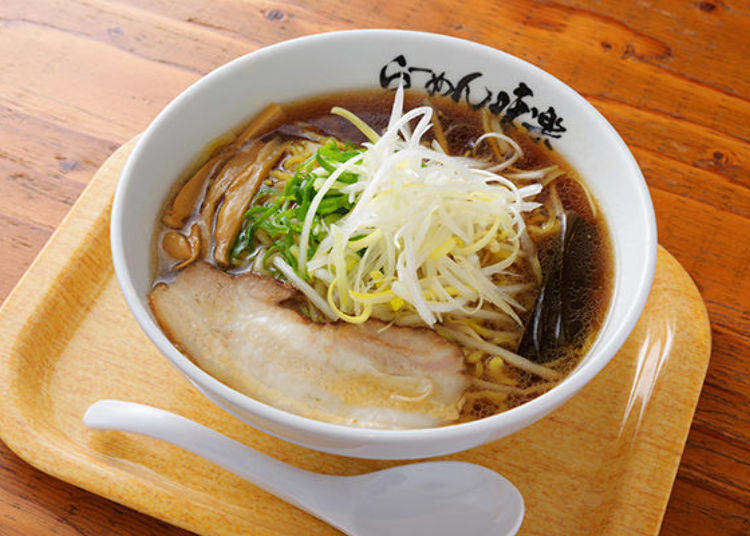
The Shin-Yokohama Ramen Museum has become a major sightseeing spot and a favorite hot spot of both ramen experts and beginners ever since it opened its doors in 1994.
It’s not only a place to learn and discover all about ramen but to savor the flavorful delicacy as well! The museum is home to several ramen shops and their noodly creations, but which ones are the best, which ones are the must-tries?
Let us take you on a ramen walk through the Shin-Yokohama Ramen Museum, diving head-first into the world of Japanese ramen!
- Table of Contents
-
- Yuji Ramen – Crazy for Tuna with the “Tuna-Kotsu” Bowl
- Muku Zweite – Abundantly Topped with European Ingredients!
- Rishiri Ramen Miraku – Kelp and Roasted Soy Sauce Take You on a Gourmet Adventure!
- Exploring the Museum Shop of the Shin-Yokohama Ramen Museum
- Our Number One Ramen Bowl: Muku Zweite Ramen!
According to our ramen expert contact who we will refer to as Yuki, who ate about 400 ramen bowls a year in their heyday. According to Yuki, the current trend in the world of ramen world is “re-import.”
Furthermore, Japanese ramen is getting recognized as its own genre of cuisine, made evident by Nakiryu, a ramen shop in Tokyo’s Otsuka, being awarded one Michelin star for the second consecutive year. Nakiryu is featured in both the Michelin Guide Tokyo 2017 and 2018.
Ambitious young people leave Japan to open ramen shops In the United States or Europe, those spots then become popular and even famous, and end up opening a branch in Japan again. Famous examples of this reverse import trend are Yuji Ramen from New York and Muku Zweite from Frankfurt, Germany. Both are found in the Shin-Yokohama Ramen Museum and we’re eager to try their bowls!
Yuji Ramen – Crazy for Tuna with the “Tuna-Kotsu” Bowl
The Shin-Yokohama Ramen Museum spans over three floors, from the ground floor to the second basement floor. Especially interesting is B2F, as it authentically recreates an atmospheric townscape of Tokyo in 1958 and it’s also where all the ramen shops line up to serve you their savory bowls!
As soon as you enter Yuji Ramen, a rich and pleasant seafood aroma will whet your appetite! The neat and stylish wooden counter is the heart of the shop, almost evoking the atmosphere of a sushi restaurant.

Yuji Ramen was opened by Yuji Haraguchi who worked as a fish wholesaler in the United States, born from the desire to somehow utilize a fish’s leftovers after it has been filleted. Thus, Yuji Ramen’s soup is characterized by its rich tuna flavor that comes from boiling these tuna leftovers at high temperature. The result is the tuna-kotsu bowl and its milky soup.

As already mentioned, tsuna-kotsu is the signboard ramen bowl of Yuji Ramen. With the first spoon, a rich and deep taste will spread in your mouth that is close to tonkotsu (pork bone) broth. The thin noodles match the flavorful soup just perfectly.
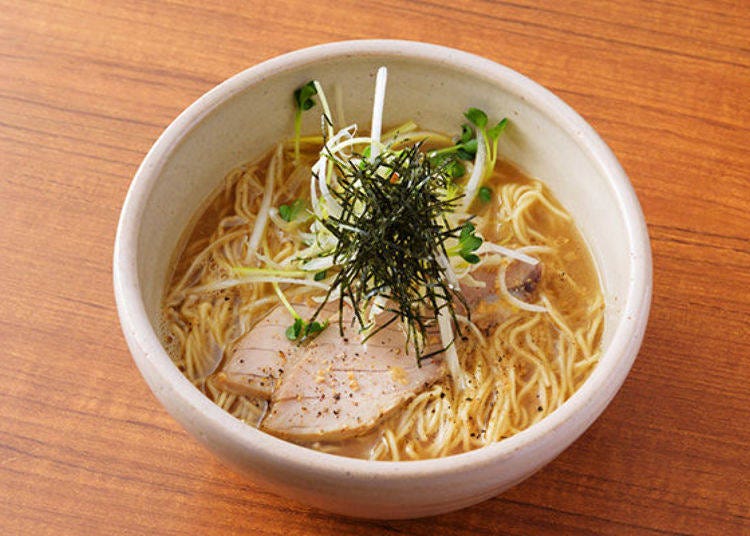
At first, you might think that radish sprouts are a bit unsatisfactory as a topping, but you’ll quickly come to love the nice balance of light crunchiness and rich soup. It’s a match made in ramen heaven!
Once you’re all done, a gentle spiciness will linger on your tongue and Ms. Sato explains to us that this pleasant tingle comes from yuzu koshō, a paste made from chili peppers and yuzu peel.
By the way: instead of the classic roasted pork, this ramen bowl is topped with tuna belly.
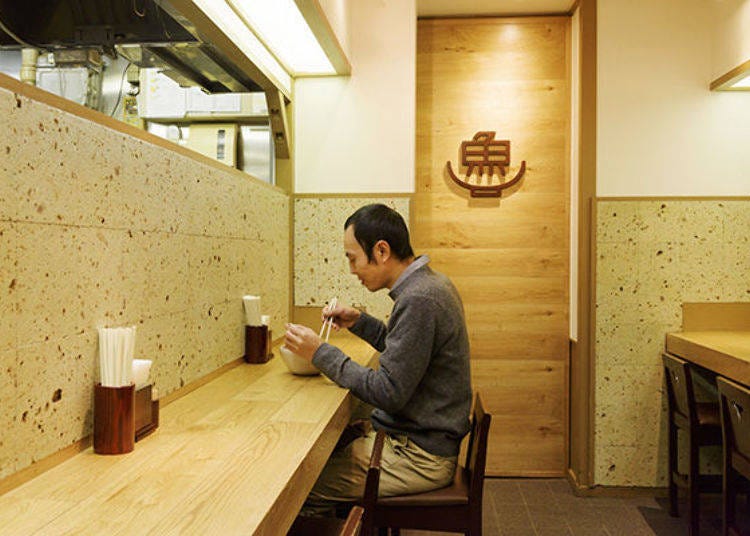
Our ramen expert Yuki told us that the Shin-Yokohama Ramen Museum has a size called “mini.” That’s a particularly great choice when wanting to try all sorts of bowls – which was exactly our plan, so we ordered a mini size of “seasonal vegetables and miso-mixed noodles.”
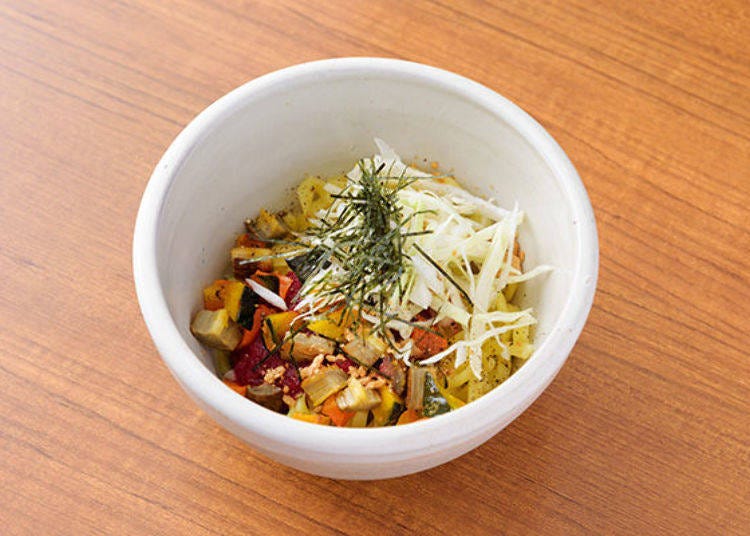
The red bits are grated beet, but that’s the seasonal aspect. In other seasons, the beet is exchanged for other vegetables. It seems like ramen is indeed becoming a “slow food.”
This is a vegetarian dish, so you won’t have to be worried about the tuna soup – there’s none in there. Instead, this bowl is seasoned with wheat miso, sesame oil, and soy sauce.
The vegetables are crunchy and boast a refreshing taste, offering a hint of salad combined with ramen noodles. It’s a great dish if you want to take a break from rich soups!
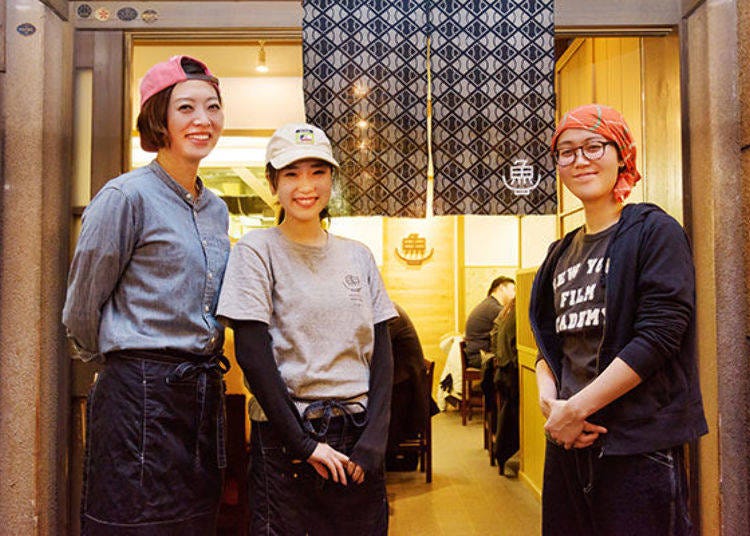
Muku Zweite – Abundantly Topped with European Ingredients!
“Zweite” a German word meaning “number two.” Muku has its main store in Frankfurt, Germany, so the shop in the Shin-Yokohama Ramen Museum is its second branch. Three four-table seats, as well as a counter invite to kick back and relax over a savory European-style bowl.
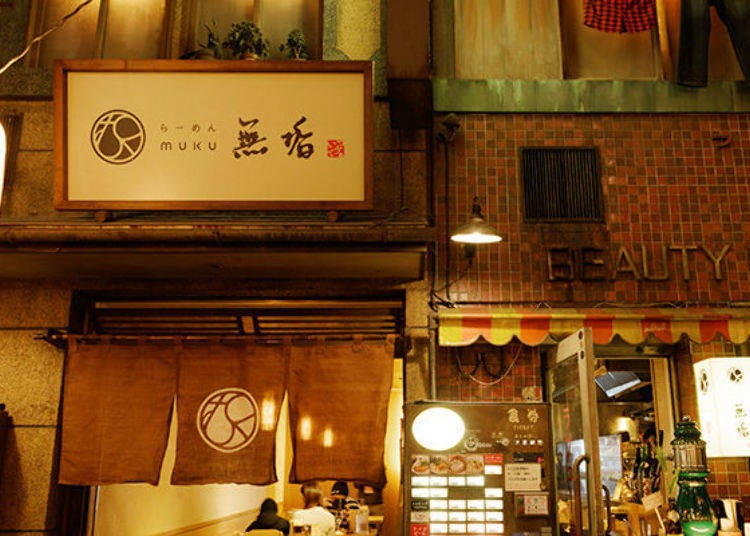
A large blackboard above the kitchen shows a menu of all sorts of snacks, such as French fries (called “Pommes” in German) and sausages, as well as German drinks including mulled wine (“Glühwein”) and Bavarian beer. We basically just walked a few meters from one ramen shop to another, and yet it feels like going from a sushi bar to a fancy German café.
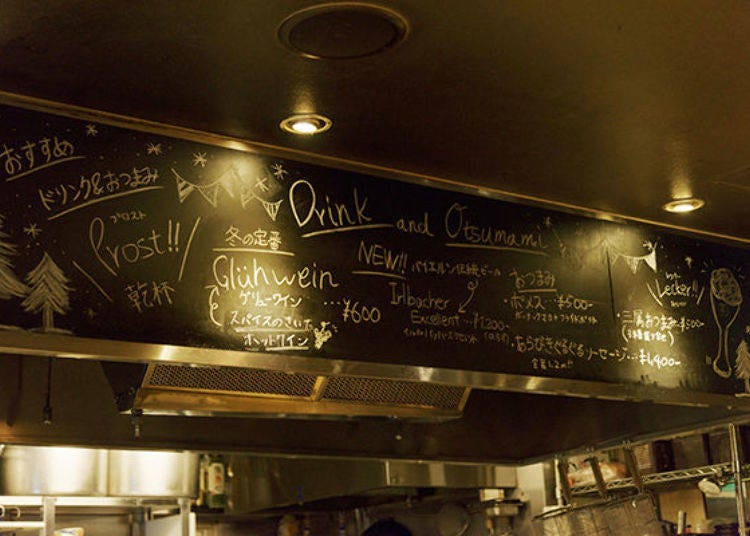
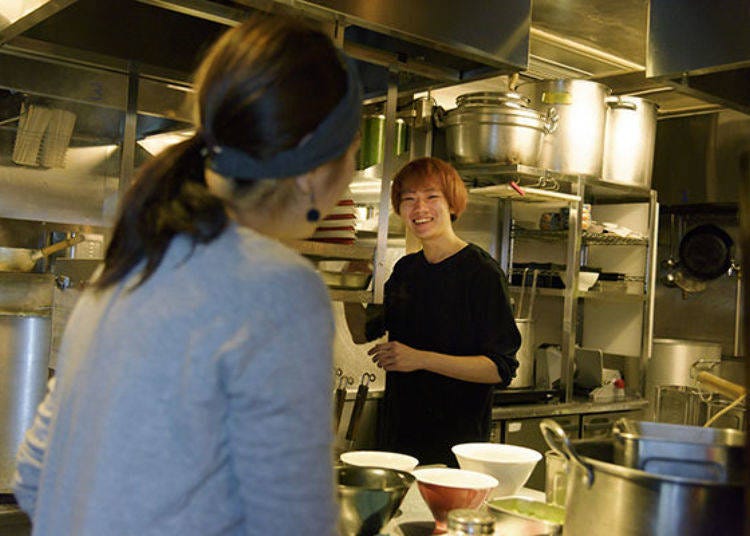
We ordered the “Muku Zweite Ramen,” named after the ramen shop. There’s no mini size available here, so we went for a regular bowl instead. It’s a flavorful fusion of Europe and Japan, with plenty of ingredients that come straight from Europe!
The soup is a blend of tonkotsu (pork bones) and chicken bones. Black pepper sprinkled on top makes for quite a visual impact and the faint sourness of sauerkraut tickles the nose.
“Ah, the taste reminds me of something... ah yes, Italian sofrito! I’m sure a glass wine goes great with this,” says our cameraman with a very satisfied face.
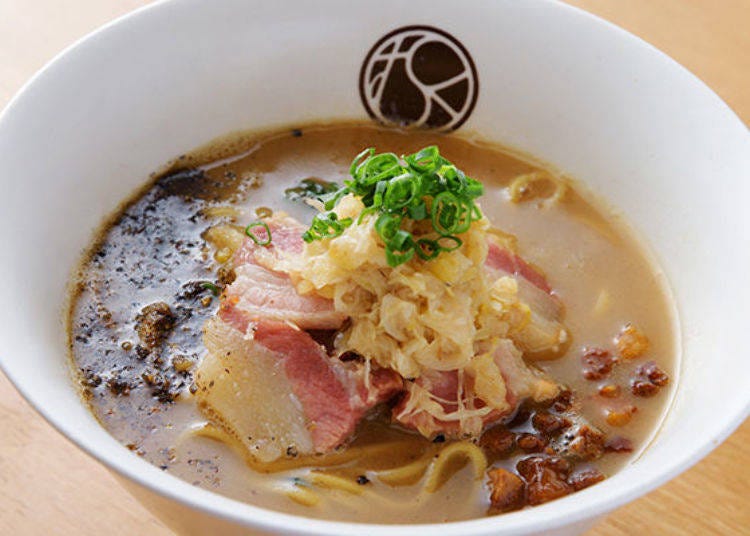
The sauerkraut is stir-fried to further unfold its tasty sourness. Apparently, adding sauerkraut, which is a fermented food, has the same effect as adding dairy products, producing a rich and deep flavor. What we thought is black pepper is actually a mix of seven kinds of peppers and spices called Sieben (literally “seven”).
The croutons aren’t just croutons either but have been fried with lard and seasoned with salt and herbs. Ramen really underwent an amazing evolution here.
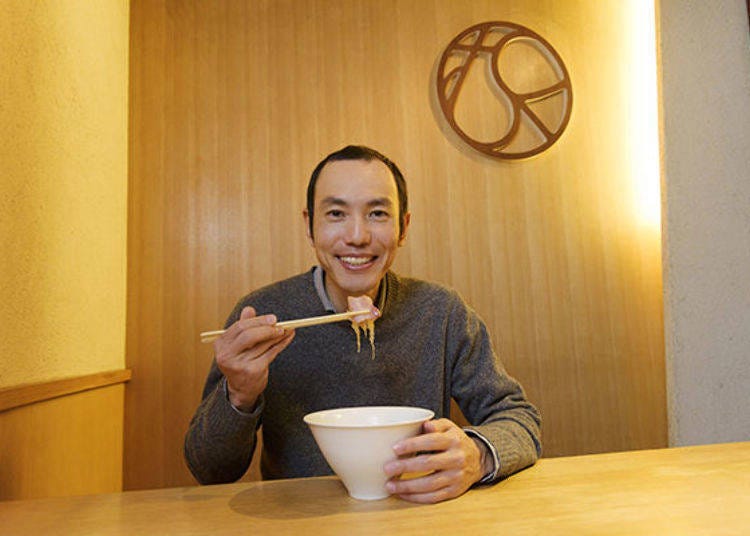
We also asked for a mini bowl of the classic “Muku Ramen,” which also hides a lot of ingenuity. Its bottom layer is kelp dashi soup and soy sauce soup, while the top layer is a creamy soup of tonkotsu and chicken bones. We are told that this is done by adding the bottom soup first, then putting the noodles in, and finally letting the top soup flow in over the back of a spoon.
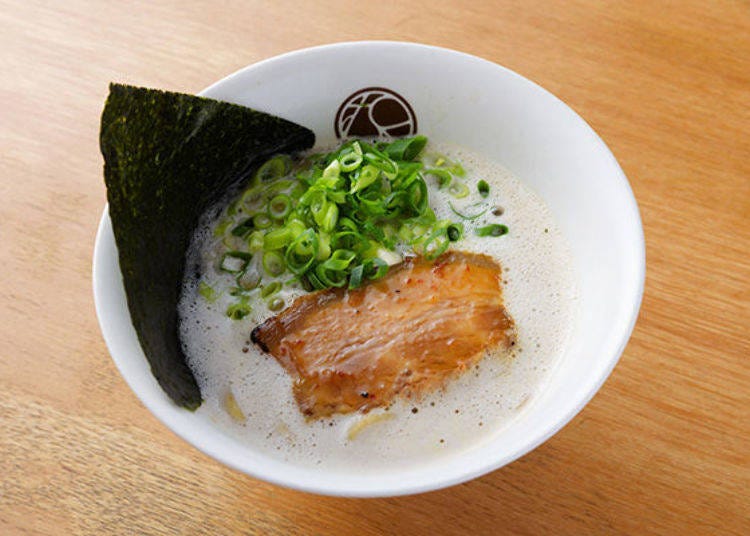
Savoring the soup alone reveals a rich flavor that is also mysteriously delicate. We wondered whether the flavors of the bottom layer of kelp and soy sauce have already blended, mixed the bowl and tried it immediately. And another spoon. And suddenly, the soup was gone!
Just like with the Muku Zweite Bowl, the extraordinarily thick noodles are made with durum flour that is also used for pizza and pasta. They are pleasantly firm to the bite and boast just the right elasticity.
The bowl is merely topped with a sheet of dry seaweed, barbecued pork, and leek so it may look a bit bland, but the focus clearly is on the uniqueness of the soup and noodles. Too many toppings would only muddle the individual flavors.
Judging the bowl as a whole, it seems to be an excellent fit for Japanese sake and shōchū.
Rishiri Ramen Miraku – Kelp and Roasted Soy Sauce Take You on a Gourmet Adventure!
After the rather heavy bowls from overseas, we’re craving an authentically Japanese ramen experience. That’s why we chose Rishiri Ramen Miraku for our third and last bowl.
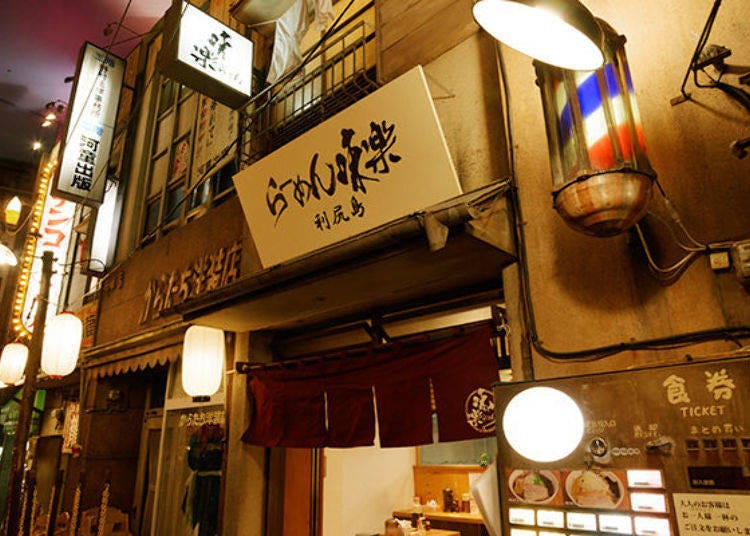
Two guys who wear T-shirts with a print of Hokkaido’s map quietly make ramen in a shop that exudes the atmosphere of an eatery at the harbor. What a calm shop! From a fancy German café to an eatery on Rishiri Island – it’s quite a jump!
The shop offers seats at two counters and five tables. While it’s a casual, laid-back place, Rishiri Ramen has been featured in the Michelin Guide Hokkaido 2012 Special Edition, as well as the 2017 Special Edition as “big gourmet,” meaning restaurants that offer an amazing gourmet experience for under 3,500 yen.
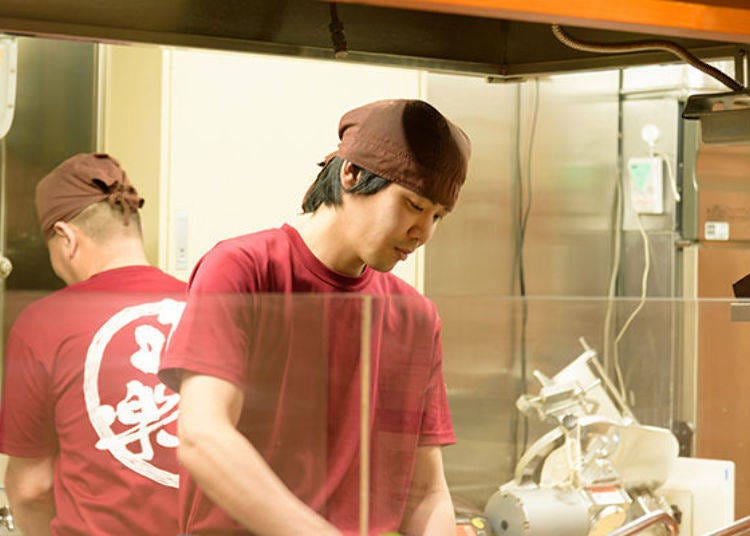
The most iconic bowl is “Yaki-shōyū ramen” (roasted soy sauce), with the soup being a blend of broth made out of kelp from Rishiri, tonkotsu, and chicken bones – it’s often called the “king of dashi broth.” The soy sauce is roasted in a Chinese wok to the point of almost burning it and a savory aroma rises from the pan. The toppings are simple but in perfect harmony: menma (fermented and dried bamboo shoots), leek, barbecued pork, and kelp. That’s all; more isn’t needed.
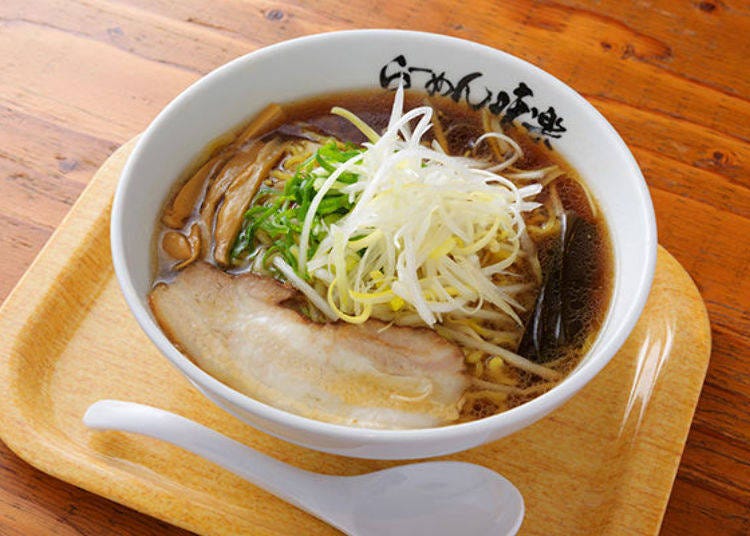
The ramen look light, but the taste is rather deep. A savory saltiness immediately recharges one’s energy! It’s the perfect bowl to have after farming seaweed at the sea all day long... It’s almost as if we can see the beaches of Rishiri in front of our eyes!
Kelp from Rishiri is a rather luxurious ingredient, with the vast majority of it being sold to restaurants via wholesalers. Rishiri Ramen uses it so generously while still keeping their bowls at a regular price because relatives of the head store’s shopkeeper are kelp farmers.
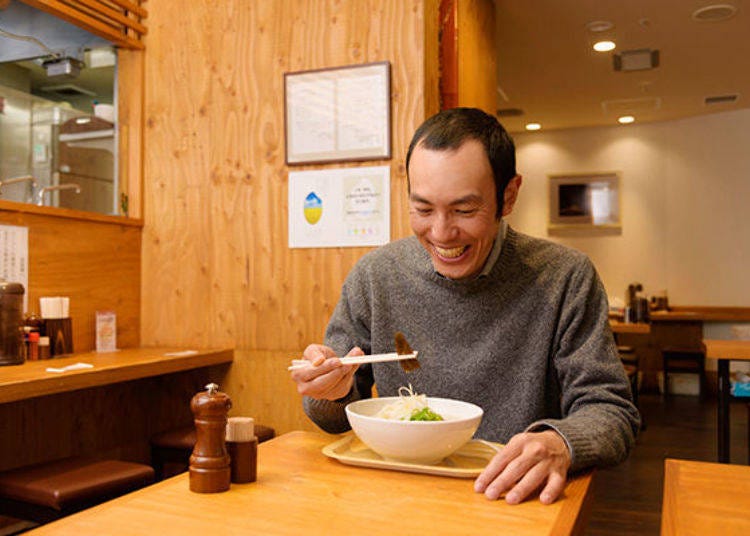
Our goal was to try and compare five different dishes at three different restaurants, but they’re all so unique and boast their own charms that comparing isn’t really an option. Every bowl being that excellent is a surprise at first – until you remember that you’re at an actual ramen museum. They’re basically exhibits!
Exploring the Museum Shop of the Shin-Yokohama Ramen Museum
When we left the store, we stumbled upon a fellow who looked just like Tora-san, the charismatic start of long-running TV movie series Otoko wa Tsurai yo (“It's tough being a man”). Performances and little picture story shows such as this one are held almost every day.
On the public tv, the Japanese professional wrestler Rikidōzan is showing off some moves while many of the shops’ exteriors feature posters of old Japanese movies such as A Fantastic Tale of Naruto and Satan's Sword.
The first basement floor has a nostalgic candy shop, as well as coffee and snacks, so make sure to stop by for a quiet coffee break or a souvenir or two. It’s an authentic recreation of Japan’s 50s, setting the stage for a one-of-a-kind ramen experience.
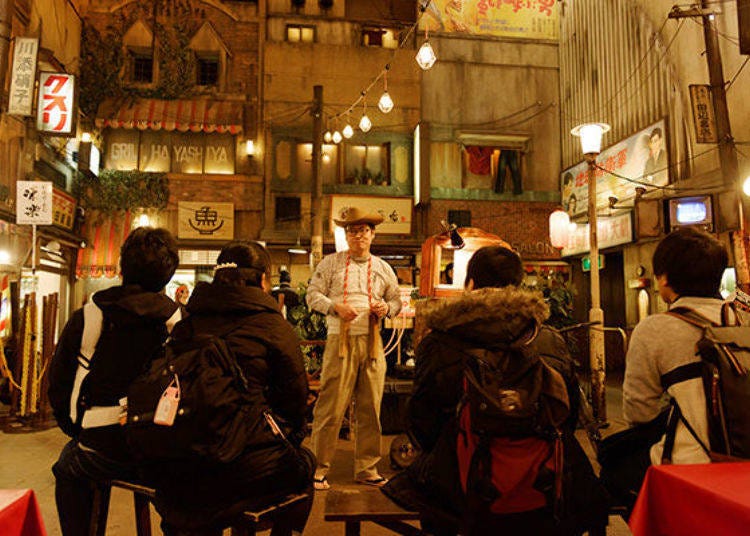
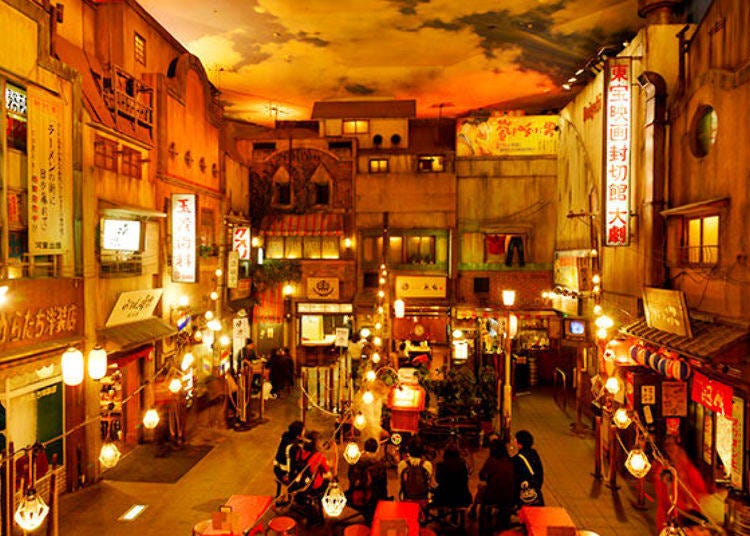
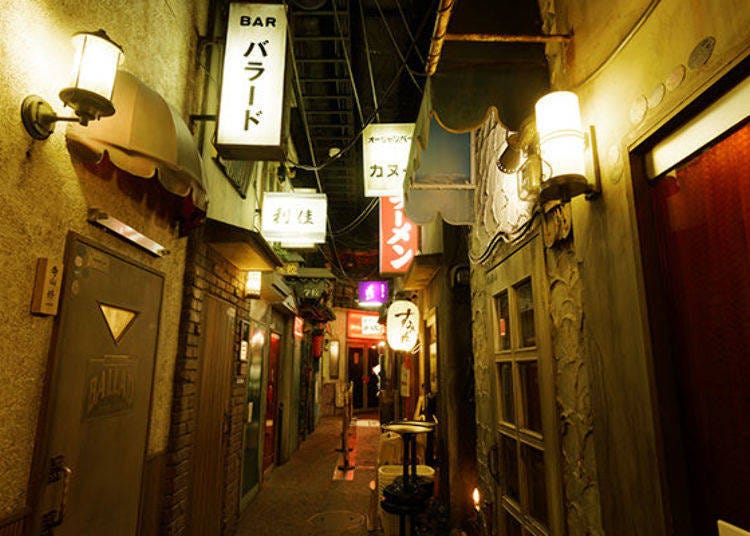
Of course, the Shin-Yokohama Ramen Museum is not just ramen shops but also showcases the history of ramen with photographs and all kinds of exhibits on the first floor. The museum shop sells the ramen of each store as souvenirs to cook them at home!
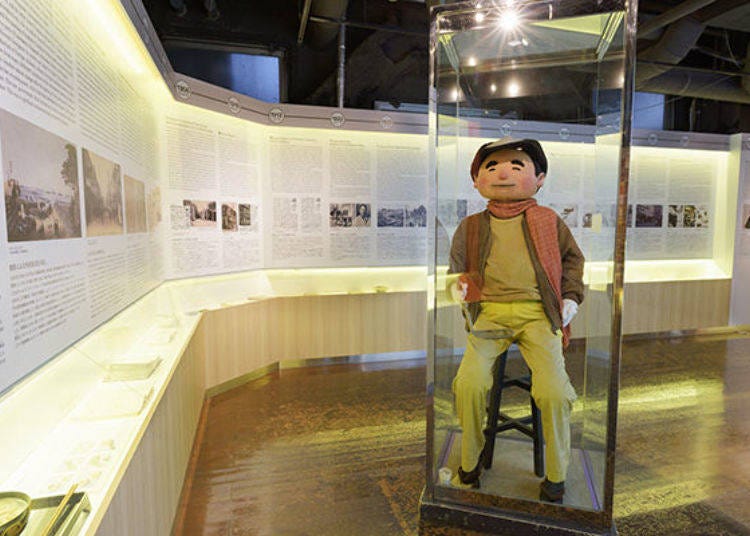
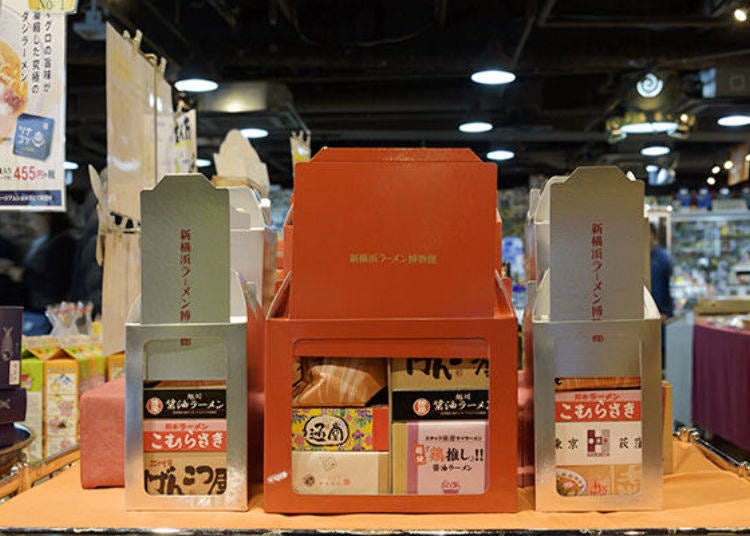
Our Number One Ramen Bowl: Muku Zweite Ramen!
This time, we tried three regular-sized ramen and two mini ramen. For one person, one regular bowl and two mini bowls should be doable, depending on how much you usually eat.
The great thing is that the Shin-Yokohama Ramen Museum puts a stamp on your hand with which you can re-enter for free. For an ultimate ramen experience, stop by for the museum and a bowl, then tour then city, and then come back again for dinner! The Yokohama Arena and the Nissan Stadium are also nearby, so why not combine your ramen adventure with a fun event?
A great time to go when it’s not too crowded is around 2 p.m. on weekdays and 3:00 p.m. on weekends and holidays.
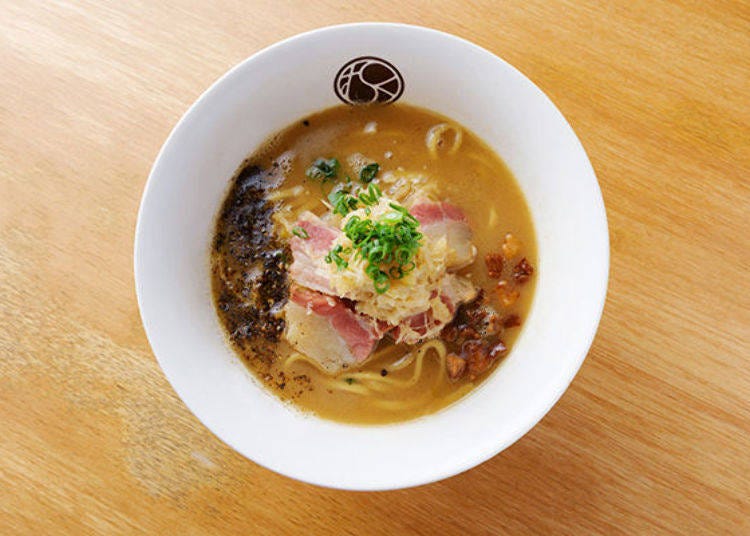
Today’s lineup was incredibly delicious, but Muku Zweite Ramen managed to stand out! Possibly because it is such a unique taste we’ve never had before – and you likely didn’t have yet either! However, it’s also the most expensive bowl...
Last but not least, there are the ramen museum’s ramen shops that we did not manage to visit this time. The main soup and head store location are given in parentheses.
- Sumire (miso / Sapporo)
- Ryu Shanghai Honten (miso / Yamagata, Akayu)
- Komurasaki (tonkotsu / Kumamoto)
- Nidai-me Genkotsu-ya (soy sauce / the former main store was in Tokyo’s Shin-Koenji but is now closed. The current store at the museum is the revived head store.)
- Shina Soba-ya (soy sauce / Yokohama)
- Ryukyu Shinmen Tondou (salt / an original of the ramen museum. Also has a branch in Okinawa’s Naha.)

With Komurasaki, which has opened as early as 1994 as a pioneer inside the ramen museum, there are currently nine regular ramen shops to be found. Apparently, it’s still not decided which stores will change and make room for newly opened ramen shops, so let’s keep an eye on it!
-

-
Address
2-14-21, Shinyokohama, Kouhoku-ku, Yokohama-shi, Kanagawa, 222-0033
View Map -
Nearest Station
Shin-Yokohama Station (Tokaido Shinkansen Line / JR Yokohama Line / Line 3 (Yokohama Blue Line) / Sotetsu Shin-Yokohama Line / Tokyu Shin-Yokohama Line)
5 minutes on foot
- Phone Number 045-471-0503
-
Address
2-14-21, Shinyokohama, Kouhoku-ku, Yokohama-shi, Kanagawa, 222-0033
Hours: 11:00 a.m. – 10:00 p.m. (open from 10:30 a.m. on Sundays and national holidays; open until 10:30 p.m. on Saturdays. Last order is 30 minutes before closing.)
Closed: open every day
Admission: 310 yen for adults (from junior high age), 100 yen for children (elementary school age), 100 yen for seniors (60 and over; all prices include tax)
(Information is accurate as of 2018. Please note times and prices may change.)
Via Gurutabi
*Prices and options mentioned are subject to change.
*Unless stated otherwise, all prices include tax.
Popular Tours & Activitiess
Recommended places for you
-
Ad

Preserving the Beauty of World Heritage Site Shirakawa-go for the Future Through Responsible Travel
-

This Winter, Godzilla Takes Over Haneda Airport
by: Guest Contributor
-
Ad

(Opening in Jan 2026) 'THE SUMO LIVE RESTAURANT HIRAKUZA GINZA TOKYO!' 5 Exciting Ways to Experience the World of Sumo!
-

How to Get Don Quijote's Exclusive 2025-2026 Winter Gift (+Tax-Free Savings)
-

First Japan Cherry Blossom 2026 Forecast Announced! Here's When & Where to See Sakura in Japan
-

Japan’s Shinkansen Is About to Change Travel in an Unexpected Way
by: Guest Contributor
Inspiration for Accommodations
-

Enjoy Mt. Fuji from the Comfort of Your Room! Recommended Ryokan with Mt. Fuji View
-

Stay Near the Cherry Blossoms! Hotels for Cherry Blossom Viewing in Tokyo
-

Family-Friendly Hotels with Free Shuttle to Disneyland: Convenient Access for a Magical Stay
-

Top Ranked Hakone Hotels with Mt. Fuji View: Enjoy Stunning Scenery from Your Private Space
-

Convenient Tokyo Hotels with Airport Shuttle: Ideal for Families and Heavy Luggage
-

Stunning Tokyo Tower View Hotels: Enjoy Spectacular Scenery from Your Private Space
-

Convenient Asakusa Hotels with Kitchens: Ideal for Extended Family Visits
-

Experience Luxury: Hakone's 10 Best Five-Star Accommodations
-

Enjoy Mt. Fuji Autumn Leaves! Top Hotels Near the Popular Autumn Leaves Corridor
-

Experience Hakone Fall Foliage from Your Room with Stunning Views
-

Exploring Tokyo: 4 Must-Visit Spots around Tokyo Station
-

Numazuko Kaisho in Ueno: Good Quality, All-You-Can-Eat Seafood for Just US$12!?
-

Tokyo Ramen Hunt: Inside the Roppongi Ramen Shop with a Theatrical Twist! (Video)
-

Autumn in Japan 2025: Fall Foliage Forecast & Where to Enjoy the Colorful Leaves (+Tour Info)
-

The Recipe for Ichiran Ramen's Global Success
-

Where to Eat in Akihabara: 3 Awesome Restaurants Recommended by Locals!
- #best ramen tokyo
- #what to buy in ameyoko
- #what to bring to japan
- #new years in tokyo
- #best izakaya shinjuku
- #things to do tokyo
- #japanese nail trends
- #what to do in odaiba
- #onsen tattoo friendly tokyo
- #daiso
- #best sushi ginza
- #japanese convenience store snacks
- #best yakiniku shibuya
- #japanese fashion culture
- #best japanese soft drinks



















